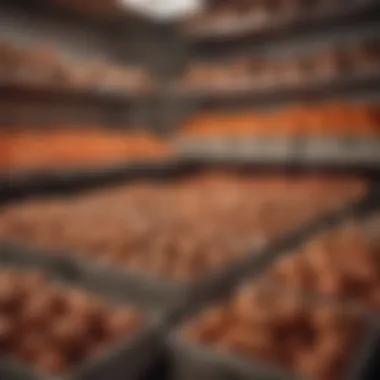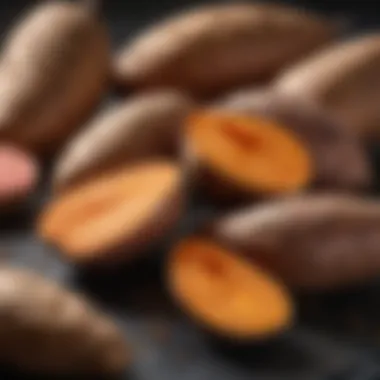Best Storage Techniques for Fresh Sweet Potatoes


Intro
Conditions for Storage
Storing sweet potatoes effectively relies on several environmental factors:
- Temperature: Ideal storage is at 55 to 60 degrees Fahrenheit. Temperatures below 50 degrees can damage them, while those above 60 might encourage sprouting.
- Humidity: A moderate level of humidity prevents the sweet potatoes from drying out. Overly dry air can lead to shriveling.
- Light: Exposure to light can trigger sprouting. Thus, sweet potatoes should be stored in a dark and cool environment.
Using a dedicated storage space, such as a root cellar or pantry, can help meet these needs. This controlled area is often the best choice for maintaining the right conditions.
Long-Term Storage Methods
1. Room Temperature Storage
For short periods, sweet potatoes can be stored at room temperature:
- Ensure they are kept in a cool, dark area.
- They should not be washed before storing, as moisture promotes decay.
2. Refrigeration Avoidance
It is wise to avoid refrigerating sweet potatoes. The cold environment can harm their flavor and texture. Refrigeration can result in undesirable changes, producing a hard center that affects taste.
3. Freezing After Cooking
If you need to store sweet potatoes for an extended period, freezing is a suitable option but only after cooking:
- Boil, bake, or mash them before freezing.
- Place them in an airtight container or freezer bag, extracting as much air as possible for optimal preservation.
Signs of Spoilage
An important aspect of storage is recognizing spoilage:
- Soft spots: These indicate decay.
- Wrinkles: Signs that they are drying out.
- Mold: A clear signal that they should be discarded.
It is crucial to inspect your sweet potatoes regularly, ensuring that only the finest remain in storage.
Summary
Effective storage of sweet potatoes involves a careful balance of temperature, humidity, and light. By applying the right methods, you can keep them fresh and flavorful for longer. Understanding how to avoid pitfalls such as refrigeration and recognizing spoilage will enhance your cooking experience with this versatile ingredient.
Prelims to Sweet Potato Preservation
Proper storage of sweet potatoes is critical for maintaining their flavor, texture, and nutritional quality. Sweet potatoes are not only a versatile ingredient in many dishes, but they also offer numerous health benefits. To maximize these benefits, understanding the preservation methods is essential. Effective storage methods can significantly prolong the shelf life of sweet potatoes, ensuring that these nutritious roots are available for use throughout the seasons.
Significance of Proper Storage
Ensuring sweet potatoes are stored correctly can prevent spoilage and waste. High-quality sweet potatoes kept in the right conditions can last for several months. Loss of moisture, exposure to light, and incorrect temperature can lead to deterioration of the tubers. Proper storage becomes particularly relevant for those managing household supplies in busy environments. Families can save money and time by employing the right techniques, maximizing the enjoyment of sweet potatoes in various meals.
Nutritional Value of Sweet Potatoes
Sweet potatoes are rich in vitamins and minerals, making them a highly nutritious food choice. They contain high levels of fiber, vitamin A, vitamin C, and several B vitamins. The antioxidant properties of sweet potatoes benefit overall health, contributing to immune support and reducing risks of chronic diseases. By storing sweet potatoes effectively, individuals can retain these health advantages longer, allowing for incorporation into a variety of recipes.
"The nutritional integrity of sweet potatoes is best preserved with proper storage techniques. They provide essential nutrients that are beneficial to a healthy diet."


Understanding Sweet Potatoes
Understanding sweet potatoes is crucial for anyone who wishes to maintain their quality and flavor during storage. Various factors influence the preservation of sweet potatoes, including their varietal differences, growth conditions, and harvesting practices. This knowledge equips food lovers, cooks, and housewives with the insight needed to maximize the sweet potatoes' storage life.
Varieties of Sweet Potatoes
Sweet potatoes come in several varieties, each with unique flavors, colors, and adequate storage characteristics. Common types include:
- Orange-fleshed varieties: These are the most popular and have a high beta-carotene content, offering a sweet flavor profile.
- White-fleshed varieties: They tend to be less sweet and drier compared to their orange counterparts, making them a versatile ingredient.
- Purple-fleshed varieties: Packed with anthocyanins, these sweet potatoes are not only visually striking but also rich in antioxidants.
Knowing the specific variety helps in predicting the storage life and optimal conditions. For example, the orange-fleshed variety, while generally sweet, can spoil faster than the drier white-fleshed types. In contrast, purple sweet potatoes can often last longer in proper conditions.
Growth Conditions and Harvesting
Sweet potatoes thrive under specific growth conditions. They prefer well-drained, sandy or loamy soil with a pH that ranges from 5.8 to 6.2. This environment is vital for developing their natural sugars, which enhances flavor and storage life. Optimal growing temperatures are between 70°F to 95°F (21°C to 35°C).
Harvesting sweet potatoes at the right time is equally important. They should be harvested after the leaves begin to yellow but before the first frost. This timing ensures the tubers reach their full flavor potential while remaining suitable for storage.
After harvesting, they should undergo a curing process for about one to two weeks in a warm, humid environment. This step helps heal any minor cuts or bruises, improving their storage resilience.
Understanding these elements ensures that individuals can effectively store sweet potatoes for prolonged freshness. Proper selection, growth conditions, and harvesting can significantly impact not just the taste but also the longevity of the produce in storage.
Factors Influencing Storage Life
When it comes to storing sweet potatoes, understanding the factors that influence their storage life is crucial. Proper storage guarantees that the natural sweetness and nutritional value remain intact for longer periods. This section will delve into three pivotal elements: temperature and humidity, light exposure, and air circulation. Each of these components plays a significant role in prolonging the life of sweet potatoes and ensuring they retain their quality.
Temperature and Humidity
Maintaining the correct temperature and humidity is essential for sweet potatoes. Ideally, sweet potatoes should be kept at a temperature between 55°F and 60°F. Both excessively high and low temperatures can accelerate spoilage. Cooler temperatures of around 40°F can lead to a condition known as "chilling injury," where sweet potatoes suffer damage that affects their texture and flavor.
Humidity levels should also be monitored carefully. Sweet potatoes require a humid environment, ideally around 85% to 90% humidity. Too much dryness can cause them to shrivel and dehydrate. Conversely, excessive moisture can promote mold growth. Regular checks on humidity levels using a hygrometer can aid in creating the perfect environment for storage.
The combination of appropriate temperature and humidity can immensely affect the preservation of sweet potatoes. Keeping these factors in check not only prevents spoilage but also maintains the sweet potatoes' characteristic taste.
Light Exposure
Light exposure is another significant factor affecting the storage life of sweet potatoes. They should be stored in a dark location away from direct sunlight. Prolonged exposure to light can cause sweet potatoes to sprout and develop green spots, which indicates a potential increase in toxicity due to solanine. Solanine is a natural compound found in nightshade plants, which can be harmful when consumed in larger quantities.
Finding a proper storage spot, such as a root cellar or a dark corner in a pantry, can help mitigate these issues. Covering sweet potatoes with a cloth can also assist in blocking out unwanted light.
Air Circulation
Proper air circulation is equally important in ensuring sweet potatoes are stored correctly. Adequate ventilation helps prevent moisture buildup, which can lead to rot or decay. Storing sweet potatoes in a well-ventilated area or using containers that allow airflow—like wooden crates or mesh bags—can improve their storage life.
Avoid stacking sweet potatoes too closely together; this can restrict airflow and cause them to spoil quicker. Instead, leave enough space between them to promote good circulation.
In summary, temperature and humidity, light exposure, and air circulation are the three main factors influencing the storage life of sweet potatoes. Understanding and managing these elements effectively can contribute to keeping sweet potatoes fresh for a prolonged duration.
Optimal Storage Conditions
Storage conditions play a crucial role in preserving the quality and longevity of sweet potatoes. Ensuring that these roots are kept at optimal levels can significantly reduce spoilage and maintain their flavor and texture. This section delves into the specific aspects of temperature and humidity, both of which can affect the overall health of sweet potatoes during storage.
Ideal Temperature Range


The ideal temperature for storing sweet potatoes is between 55°F and 60°F (13°C to 16°C). This range is critical because it helps slow down the respiration process, which can lead to quicker spoilage. If exposed to higher temperatures, sweet potatoes may sprout, and at lower temperatures, such as in a refrigerator, the cells can become damaged, resulting in a hard core or undesirable texture.
When choosing a location for storage, consider areas like a dark basement or a root cellar. These spaces usually maintain a stable temperature and can help provide the right environment. Keeping sweet potatoes in cardboard boxes or paper bags can also help insulate them from sudden temperature fluctuations.
"Maintaining a consistent temperature is key to ensuring your sweet potatoes remain in good condition for longer."
Recommended Humidity Levels
Humidity is another important factor that influences the preservation of sweet potatoes. An ideal storage environment should have a humidity level between 85% and 90%. This humid atmosphere prevents the sweet potatoes from drying out, which can lead to shriveling and loss of flavor.
To achieve these recommended humidity levels, consider storing sweet potatoes in bins with damp sand or using a humidifier in a small storage area. However, it is crucial to avoid excessive moisture, as this can promote mold growth and decay. Regular checks and adjustments can help maintain the right balance between moisture and ventilation.
By controlling both temperature and humidity, you create a conducive environment for your sweet potatoes, allowing you to enjoy their deliciousness for an extended period. Emphasizing the significance of maintaining these optimal conditions can lead to more effective storage practices and better meal preparation outcomes for food lovers at home.
Methods for Storing Sweet Potatoes
Storing sweet potatoes effectively ensures that their nutritional value and flavor remain intact for extended periods. Proper methods in storage not only prolong shelf life but also enhance the tastes of this versatile vegetable, making it essential for both culinary enthusiasts and everyday cooks. Techniques vary, based on available space and durations intended for storage. Understanding various techniques aids in preserving sweet potatoes while also minimizing waste, making it a relevant topic for people who regularly incorporate sweet potatoes into their meals.
Storing in a Root Cellar
A root cellar is an ideal environment for storing sweet potatoes. The consistent cool temperatures and humidity levels mimic the natural underground conditions in which these tubers thrive. When storing sweet potatoes in a root cellar, ensure that the space is dark, as prolonged light exposure can encourage sprouting. The right humidity levels, typically around 85-90%, help to prevent the tubers from drying out. Arrange the sweet potatoes in a single layer to allow adequate air circulation. Using straw or paper to separate them can also help maintain moisture.
Utilizing a Pantry
For those without a root cellar, a well-ventilated pantry can be a practical alternative. The pantry should be cool, dry, and dark. Avoid storing sweet potatoes near onions or garlic, as these can emit ethylene gas, which can cause premature spoilage. Place the sweet potatoes in a basket or a cardboard box, allowing air to circulate freely. Regularly check for any signs of sprouting or soft spots, removing any problematic tubers promptly to prevent contamination of the others.
Using the Refrigerator
Refrigeration is often not advised for sweet potatoes, as cold temperatures can alter their flavor and texture. However, if your climate is particularly warm or humid, refrigeration may serve as a temporary solution. Before placing sweet potatoes in the refrigerator, ensure they are clean and dry. Store them in a perforated plastic bag to allow airflow. Be aware that while this method can prolong storage for a short duration, it is best to consume them soon after refrigerating. Once removed from the cold, allow them to return to room temperature for optimal flavor.
Freezing Sweet Potatoes
Freezing sweet potatoes can serve as an excellent way to extend shelf life for several months. Before freezing, it is crucial to prepare them properly. First, clean and peel the sweet potatoes. Next, cut them into slices or cubes and blanch them in boiling water for approximately three to five minutes. This process helps to deactivate enzymes that can affect flavor and color. After blanching, immediately transfer the sweet potatoes to ice water for quick cooling. Once cooled, drain them well and package in airtight containers or freezer bags, ensuring to remove as much air as possible. Label and date the packages for future reference to ensure their freshness when you decide to use them later.
Pre-Storage Preparation
Pre-storage preparation is crucial when it comes to preserving sweet potatoes effectively. Proper preparation can significantly extend the storage life and maintain the quality of these tubers. By ensuring that sweet potatoes start their storage journey in the best possible condition, home cooks can enjoy their flavor and nutritional benefits for longer.
Cleaning Sweet Potatoes
Cleaning sweet potatoes involves removing any dirt and debris. This is an essential first step. It is important to avoid using soap or chemicals during the cleaning process, as residues can affect taste and safety. Instead, it's best to rinse sweet potatoes under cool running water. Gently scrub them with a soft brush to remove all soil particles without damaging the skin. This helps to prevent rot, which can occur if tubers are put into storage with any lingering moisture or dirt. Once cleaned, it is advisable to dry them completely using a clean towel.
Proper Curing Techniques
Proper curing techniques are vital for enhancing the sweetness of sweet potatoes and increasing their longevity. The curing process allows the skin to toughen, thereby protecting against spoilage. To cure sweet potatoes, place them in a warm, dark, and ventilated area for about one to two weeks. The ideal temperature is around 80°F to 85°F with a humidity level of approximately 85%.
During this period, it is crucial to monitor the environment. Proper air circulation should be maintained to avoid mold growth. After curing, it is important to store sweet potatoes in a cool, dark location, away from direct light. This will help to maintain optimal freshness and flavor.
Key Takeaway: Cleaning and curing sweet potatoes effectively is essential for maximizing their storage potential. Neglecting these steps may lead to reduced quality and shorter shelf life.
Following these pre-storage preparation steps will ensure that sweet potatoes remain fresh and flavorful for many meals to come.
Common Mistakes in Storage


Storing sweet potatoes correctly is critical for maintaining their shelf life and flavor. Mistakes in storage can lead to spoilage, waste, and loss of nutrients. Addressing common errors not only ensures that sweet potatoes remain edible longer but also preserves their quality for meal preparation. Here, we will outline significant mistakes that many individuals make when storing sweet potatoes.
Avoiding Moisture
One of the main mistakes in sweet potato storage is not paying attention to moisture levels. Excess moisture can lead to mold growth and rot. When sweet potatoes are stored in a humid environment, they absorb moisture, which makes them prone to decay.
To prevent moisture-related issues, follow these guidelines:
- Choose breathable storage containers: Use boxes or bags that allow airflow. This helps to regulate humidity levels around the sweet potatoes.
- Store in a cool, dry place: A temperature range of 55 to 60 degrees Fahrenheit is ideal. Keep them away from damp areas, such as basements, where moisture tends to accumulate.
- Use absorbent materials: If necessary, place paper towels in storage containers to soak up excess moisture.
"Mind the moisture – it can be the difference between fresh and spoiled sweet potatoes."
Recognizing Ethylene Exposure
Another common mistake in sweet potato storage is failing to recognize exposure to ethylene gas. Ethylene is a hormone produced by some fruits that can significantly affect the ripening process of vegetables. Sweet potatoes are sensitive to this gas, which can accelerate spoilage.
To mitigate this risk, consider the following:
- Store away from ethylene-producing fruits: Apples, bananas, and tomatoes are known to emit ethylene. Keep sweet potatoes separate from these fruits to prolong their freshness.
- Check storage areas regularly: Inspect sweet potatoes for any sign of decay or spoilage, which may indicate ethylene exposure. Remove any affected ones promptly.
- Utilize dedicated storage space: If possible, designate a specific area for storing sweet potatoes, free from ethylene-producing items.
By avoiding these common mistakes, you can protect the quality and extend the shelf life of your sweet potatoes. This ensures that they remain a healthy and delicious ingredient in your meals for a longer period.
Signs of Spoilage
Recognizing the signs of spoilage is critical for anyone who wishes to maintain the quality and safety of their sweet potatoes. Spoiled sweet potatoes can not only taste unpleasant, but they can also pose health risks. Monitoring for spoilage is a proactive step that ensures your investment in fresh produce does not go to waste. Understanding how to identify spoilage can aid in meal preparation and enhance your culinary experience.
Identifying Soft Spots and Decay
One of the first indicators of spoilage in sweet potatoes is the presence of soft spots. These areas may feel mushy or may appear sunken compared to the rest of the tuber. Firmness is a sign of freshness. When inspecting your sweet potatoes, gently squeeze different sections to identify any soft spots. These spots indicate that the integrity of the flesh is compromised, potentially harboring bacteria and other pathogens.
Accumulation of moisture, often from an unsuitable storage environment, can result in decay. When decay sets in, it typically causes an unpleasant odor. If a sweet potato emits a foul smell, it is best to discard it immediately. In sum, soft spots and decay are usually signs that sweet potatoes are no longer safe for consumption or cooking.
Recognizing Color Changes
Color alterations are another significant sign of spoilage in sweet potatoes. Healthy sweet potatoes boast a vibrant color, whether it be orange, purple, or yellow depending on the variety. Typically, these colors may dull or change entirely when spoilage occurs. For instance, if the sweet potato exhibits a darkened or brownish hue, it may suggest that it is past its prime.
Moreover, if you notice any discoloration accompanied by mold growth, this requires immediate action. Mold can spread quickly not just to the visible area but throughout the vegetable. Color changes can serve as an early warning system for consumers, alerting them when it’s time to check the quality of their storage methods and process any affected produce.
It is essential to regularly inspect sweet potatoes for signs of spoilage. Prompt recognition can save both your effort in cooking and your health.
The End
Understanding the various methods of storing sweet potatoes is crucial for maintaining their quality and extending their shelf life. This article has detailed best practices that ensure sweet potatoes remain fresh and nutritious. The relevance of effective storage techniques cannot be overstated, as improper handling can lead to spoilage, loss of flavor, and waste.
By following the outlined steps—from optimal conditions to appropriate methods—consumers can enjoy sweet potatoes at their best. Proper storage allows families to save time and money by reducing the frequency of grocery shopping. Moreover, with increasing awareness about food sustainability, applying these techniques has significant benefits for the environment as well.
Ultimately, the knowledge of storing sweet potatoes not only enhances culinary experiences but also encourages thoughtful food management in households.
Summary of Best Practices
- Keep in a cool, dark place: Aim for a temperature range of 55-60°F.
- Maintain humidity: Ideally between 85-90%. This prevents dehydration.
- Ensure ventilation: Air circulation helps avoid mold and rot.
- Avoid refrigeration: Storing sweet potatoes in the refrigerator can lead to a hard center and an unpleasant taste.
- Inspect regularly: Check for decay or soft spots and remove spoilage.
Following these guidelines can prolong the shelf life of sweet potatoes significantly.
Future Insights on Sweet Potato Storage
The future of sweet potato storage could include more advanced technology tailored for home use. As food preservation technologies develop, innovations such as smart storage containers with humidity and temperature controls may become available. These could help automate the monitoring of ideal conditions for sweet potato preservation.
Research on natural preservatives and their application in home storage is also promising. Techniques aimed at extending the shelf life while retaining nutritional content are on the rise. As awareness surrounding healthy eating increases, consumers may benefit from tailored resources that focus on the specific needs of sweet potatoes, such as their resistance to certain pests or diseases in storage.







